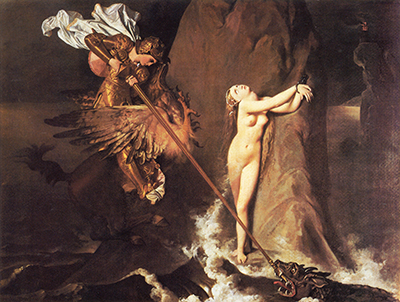Roger Freeing Angelica was a large and complex painting by Jean-Auguste-Dominique Ingres from 1819 and it can now be found at the Louvre in Paris, France.
Ingres is known to have produced several different variations on this theme, with the painting shown here being comfortably the most famous. Art historians generally accept that this work was inspired by an earlier work, namely Orlando Furioso by Ariosto which was an Italian poem from the 16th century. Inspiration for artists from literature is of course wide spread, and has been the case for many centuries, going back way beyond even the early stages of the Renaissance.
In this scene we find a knight riding a Hippogriff along the French coast, when suddenly he comes across a damsel in distress. In this case it was a stunning woman by the name of Angelica, who is in need of rescue. Her saviour finds her chained to rocks, petrified about her impending demise. She has been left there as a sacrifice and is running out of time before a sea monster arrives to accept this gift. The fairly predictable outcome is that the monster is slain by the knight and she is freed. A Hippogriff, incidentally, is a creature from ancinent mythology which consists of half horse and half eagle.
Ingres later returned to this painting in 1859 and took the female figure from the original and placed her in much the same pose. In this newer example she was by herself and the canvas was delivered in a tondo. She is near identical to the earlier Roger Freeing Angelica. This was a commissioned piece and it was immediately exhibited upon completion at the Paris Salon, as he did with most of his major paintings whilst residing in France. It was placed alongside Grande Odalisque in what was clearly a key period in the career of Ingres.




